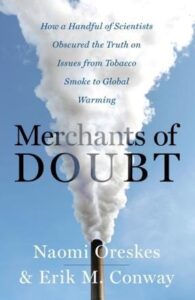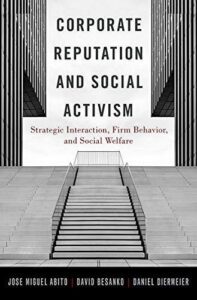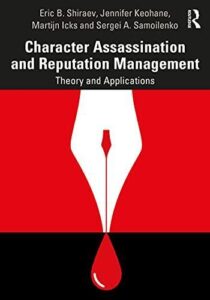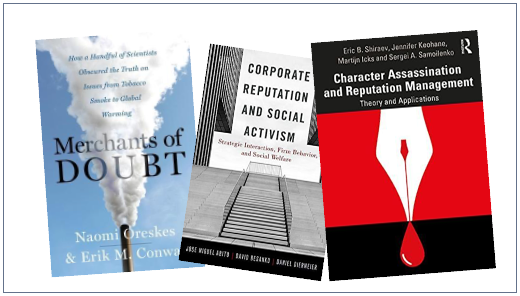“Three Books to Learn About Corporate Disinformation” is a paper written by team members of Team #Boycott Biz in Spring 2023.
Three Books to Learn About Corporate Disinformation
Misha Simanovskyy, Ksenija Angelina Braese, Abigail Eichenberg
(#BoycottBiz)
Takeaways
1. Spreading doubt has been the most effective mechanism for countering facts and evidence.
2. Activists have turned to consumer boycotts and divestment campaigns after realizing that protesting corporate action by invoking government action was slow and ineffective to get the job done.
3. Character attacks are especially prevalent in today’s media environment, where individuals are constantly bombarded by politicians, corporations, and other entities attempting to influence their opinions.
 Oreskes, Naomi, and Erik M. Conway. Merchants of doubt: How a handful of scientists obscured the truth on issues from tobacco smoke to global warming. Bloomsbury Publishing USA, 2011.
Oreskes, Naomi, and Erik M. Conway. Merchants of doubt: How a handful of scientists obscured the truth on issues from tobacco smoke to global warming. Bloomsbury Publishing USA, 2011.
“Merchants of Doubt” is a captivating piece of outstanding investigative and scholarly work by two historians of science. The authors argue that spreading doubt is the most effective mechanism for countering facts and evidence. The book identifies concerning parallels between the ongoing controversy about the nature of global warming and previous debates over tobacco smoking, DDT, and the hole in the ozone layer. Oreskes and Conway center the book around contrarian scientists addressing actively debated contemporary issues. These scientists are the merchants of doubt responsible for stirring public controversy around climate change today and for topics such as tobacco smoking decades earlier. The book highlights Fred Seitz, Bill Neirenberg, Robert Jastrow, and a few others who have strong convictions that are antithetical to the existing (or emerging) consensus in the scientific community. Frequently, unconventional scientists like these are supported by a network of laissez-faire think tanks, such as Competitive Enterprise Institute and the Heritage Foundation, directly or indirectly funded by corporations and foundations interested in constraining government regulation to a minimum.
These conservatively leaning scientists staunchly oppose government intervention into any sphere of public life and consider the current emphasis on environmentalism and climate change as an outgrowth of state interference and a step towards socialism and communism. However, Oreskes and Conway note that by obstructing milder government action early on, these individuals are delaying the problem, transforming their worries about the growing role of the state into a self-fulfilling prophecy. It is only a matter of time until these issues will exacerbate and require even more stringent and steadfast government action to halt the deterioration, and ultimately turn the tide back, such as in the case of the ozone layer hole. Oreskes and Conway posit that ‘merchants of doubt’ are salesmen rather than scientists. Legitimate scientists would not have the time or drive to constantly engage in public relations instead of conducting actual scientific work. The only product of Seitz, Neirenberg, Jastrow, and their likes is a proliferation of doubt rather than a generation of knowledge.
The book highlights that the human mind can be easily manipulated and tricked into believing falsehoods. On average, people might prefer the more compelling and provocative alternative reality to the simple, obvious, and verifiable facts. A major takeaway is that the media can play a key role in disseminating doubts perpetrated by what might be considered authoritative figures. Mass media is not restrained by rigorous fact-checking or peer review, a verification tool used in the academic press. Therefore, the media can fundamentally undermine public trust in the institutions of authority and give way to corporate disinformation taking root in people’s minds without leaving a suspicion of being manipulated. Character assassination can be used in conjunction with corporate disinformation to discredit those who are trying to expose wrongdoing and to foster a climate of mistrust that makes it easier for businesses to disseminate false or misleading information without being held accountable.
 Abito, Jose Muguel, David Besanko, and Daniel Diermeier. Corporate reputation and social activism: Strategic interaction, firm behavior, and social welfare. Oxford University Press, 2019.
Abito, Jose Muguel, David Besanko, and Daniel Diermeier. Corporate reputation and social activism: Strategic interaction, firm behavior, and social welfare. Oxford University Press, 2019.
Published by Oxford University Press in 2019 and penned by three prominent academics, Corporate Reputation and Social Activism: Strategic Interaction, Firm Behavior, and Social Welfare is a short but thought-provoking descriptor of how corporate campaigns and private regulation from activists influence corporate reputation and firm policies. Rather than exclusively turning to executives, shareholders, and external consultants for advice on how to run a business organization, corporate decision-making is now also influenced by private politics. Private politics consist of actions by private interests such as non-governmental organizations that target firms and corporations — which slowly became the preferred process of influencing private agents after years of systemic gridlock through public processes like regulatory enforcement and lawsuits. In the opening pages of the book, the authors bring up a powerful example of private politics — a 2013 garment factory collapse in Bangladesh that killed over 1,000 underpaid workers manufacturing clothes for Western fast fashion retailers like Disney, Gap, and H&M. Public backlash towards these companies was fierce, leading them to commit to renewed standards for their outsourced employees or pulling out of unsafe labor markets entirely.
The reviewed book reiterates what seems to be common sense — private corporations are driven by profit, and whichever action drives the highest return on investment is usually what companies pursue. Similarly, an outside actor (activist, NGO, or similar private political entity) with the potential to disrupt earnings can provoke a corporation to pursue reputation-enhancing private regulation, such as Disney leaving the Bangladeshi labor market entirely post-2013 garment factory disaster or the decision of hundreds of multinational corporations to leave Russia after the country’s brutal invasion of neighboring Ukraine in February 2022.
Abito et al. describe the two main strategies activists use to influence private corporations: criticism and confrontation. The authors claim criticism is “more constructive” and relies on gently “changing business practices.” In contrast, confrontation is the more aggressive method that intends to create significant “mass media coverage that is critical of the firm (p. 55).
While most literature on fake news and disinformation focuses on companies as victims of disinformation, there is little written about corporate firms as active sources of deliberate falsehoods. In the context of corporate social responsibility, corporate disinformation exists in the form of corporate responses to private politics. The more constructive method of criticism by activists might not evoke a response from the firm in question, but aggressive confrontation tends to do so. In the latter scenario, a company can either choose to gracefully abide by the public’s requests (like H&M in Bangladesh) or outright refuse, often issuing false excuses (as a form of corporate disinformation) in their wake. Similarly, misleading and decontextualized information released in response to public backlash also amounts to corporate disinformation.
 Shiraev, Eric B., Jennifer Keohane, Martijn Icks, and Sergei A. Samoilenko. Character assassination and reputation management: Theory and applications. Routledge, 2021.
Shiraev, Eric B., Jennifer Keohane, Martijn Icks, and Sergei A. Samoilenko. Character assassination and reputation management: Theory and applications. Routledge, 2021.
In “Character Assassination and Reputation Management,” the authors comprehensively examine character assassinations, utilizing historical and modern examples from around the world. Character assassinations are considered successful character attacks, described by the authors as acts taken by individuals or groups meant to question and damage an individual’s character.
Through multiple chapters, the authors present the “five pillars” of character assassination: the attacker, the target, the medium, the audience, and the context. The attacker is the entity that launches the character attack against the target and can be driven by a plethora of motives, including but not limited to damaging a political opponent’s reputation, eliminating competition, increasing sales, or even taking revenge. The target is the individual whose reputation – through their personality, behavior, and social identity – is under attack. The target only becomes a victim of character assassination when the attack against them is successful. The medium refers to how the character attack is delivered through interviews, tweets, or campaign ads. The authors describe the audience as crucial for the success of the character attack; their response determines whether or not the attack is effective. The last pillar, context, refers to the political landscape, cultural norms, economic and technological circumstances, and other external factors influencing character attacks.
The authors explain that character assassinations can be separated into three distinct categories; provocation campaigns which create events in the media or amplify a target’s crisis, contamination campaigns which spread rumors and misinformation through social networks; and obliteration strategies, which aim to erase memories related to a public figure.
Character attacks can occur in practically any field or country and – depending on the attack’s reception and goals – can have varied impacts. Media has made it significantly easier to initiate attacks against individuals and to present the attack to a broad audience. The authors provide three steps that can be taken to manage character attacks: preparedness and prevention, image repair, and post-crisis communication. These steps aim to transition from a state of reputation risk to a state of managed reputation.
Corporate disinformation is examined in this book through corporate character assassination. Character attacks aimed at companies or high-ranking corporate employees can significantly threaten stock values and a company’s reputation. Malicious actors use the same tactics and creation and distribution methods as politically motivated disinformation campaigns. Attackers use these corporate disinformation campaigns to eliminate market competition, increase the sales of the target’s main competitors, and cause general disruption of production or sales. Because social media has become vital in disseminating disinformation, companies must monitor social channels so that they are alerted when disinformation about their company is being spread.

